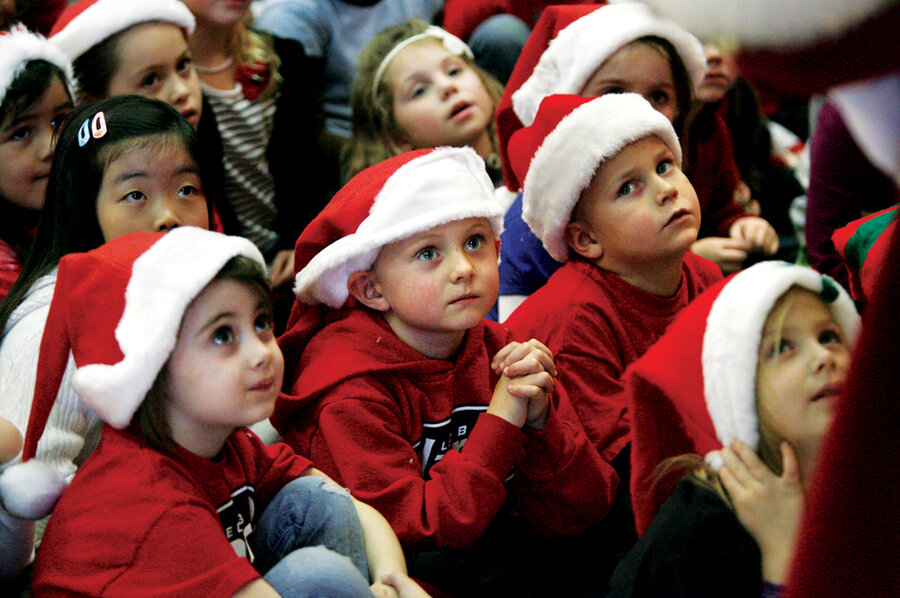Santa Claus? Yes and no, Virginia.
Loading...
Dear Editor: I am 8 years old. Some of my little friends say there is no Santa Claus. Papa says, “If you see it in The Sun it’s so.” Please tell me the truth; is there a Santa Claus?
– Virginia O’Hanlon, writing to the New York Sun, 1897
Virginia, your little friends are affected by the skepticism of a skeptical age. But your dad – whoa. Doesn’t he listen to talk radio or follow the blogs, tweets, or Facebook feeds of presidential hopefuls and reality-show celebrities? Hasn’t he heard of the “lamestream media”?
I’m as proud of my profession as any other handsomely compensated editor, but Papa might remember that the old New York Sun is the newspaper that in 1835 published what is known as “The Great Moon Hoax,”a six-part series that described astronomical observations of life on the moon. It was a fabulous tale – walking beavers, bat-winged humanoids, amphitheaters made of ruby. The reports by “Dr. Andrew Grant” were great for circulation. Credibility? Not so much, beginning with Dr. Grant, who, uh, didn’t exist. Let’s just say that if Papa sees a story in the Sun (the 19th-century version, not the Web-only 21st century version) he might want to check it out on Snopes.com or Factcheck.org.
Anyhoo. Back to Santa. There are two answers to that. Yes, Virginia, there is a Santa Claus. There are thousands of them. You’ve seen them outside the grocery store, at Macy’s, on TV, at holiday parties. They are at the center of the all-out commercial culture that retailers, advertisers, and newspapers have been promoting since the 19th century. Christmas spending is the engine of the retail economy. Nothing wrong with that, as long as you and all the other Virginias keep your spending modest and don’t run up the credit cards.
I’m guessing, though, that you are really wondering if there is one true Santa living at the North Pole with magical elves, flying reindeer, and, of course, that naughty/nice list. That’s a tough one. I don’t want to rob childhood of its sweetness any more than another old newspaperman, Francis Pharcellus Church, did in the original Sun when he praised your “childlike faith” and told you, “The most real things in the world are those that neither children nor men can see.”
He was right about that. There’s more to life than we get from our senses. May I suggest that you and Papa and Mama have a talk rather than writing to a newspaper? Newspapers can give you information and context, but it is at home that you will begin to understand the unseen. Parents are the primary guide of what children believe, whether it is religion or nutrition, favoring a local sports team or trusting the media. Faith starts at home.
And faith is indeed what we’re talking about, Virginia. There’s precious little of it to go around. In many ways, that’s a good thing. Thinking people of all ages should always be asking questions and seeking proof of assertions. Opinions are cheap and attitudes are easy to cop. Science, philosophy, government, journalism – all only get better when tough questions are asked and answered.
But while blind faith in people and institutions isn’t healthy, that doesn’t mean there’s no room for looking at the stars and wondering why we are here and what our purpose is. You may not know the answer rationally, but you can feel it. And if you look around with a certain kind of appreciative vision, you can see it. It doesn’t take fantasy characters with red suits and white beards. It doesn’t require toys under the tree. It’s there in an unexpected smile or the way you feel when you do something good even when no one is looking.
A much earlier writer called that “the evidence of things not seen.” Faith in Santa? Not necessary, Virginia. But faith in what Mr. Church called “the supernal beauty and glory beyond”? Yes, Virginia, you can definitely have faith in that.
John Yemma is the editor of The Christian Science Monitor.





